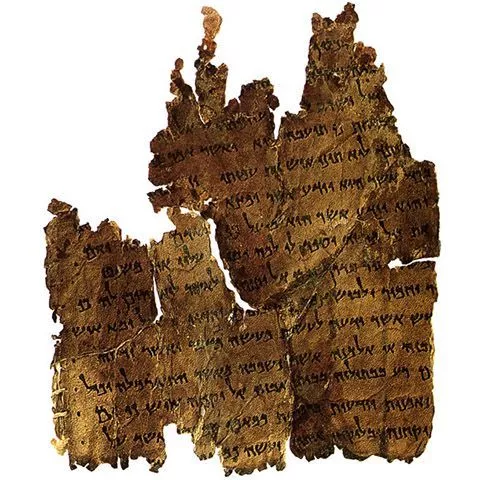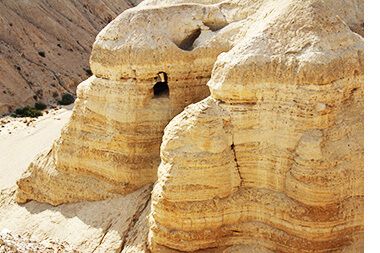The Dead Sea Scrolls – Qumran

The Dead Sea Scrolls are one of the greatest archaeological discoveries in history because of their biblical as well as historical significance.
The Dead Sea Scrolls consist of scrolls and fragments which include all of the Old Testament books (except Ruth), as well as sectarian and apocryphal texts all dating to the second temple period. This discovery was vital for biblical scholars and historians alike, creating a new standard for biblical textual analysis. Before this discovery, biblical scholars relied upon the Masoretic text, dating to the 10th century A.D., as the earliest known Old Testament Hebrew manuscripts. The Dead Sea Scrolls date from 250 B.C. up to 70 A.D., providing scholars with a biblical text from almost a thousand years earlier. Almost 70 years after their discovery, the Dead Sea Scrolls is still one of the most highly debated topics within biblical studies, and a complete education on the subject would take a lifetime to learn.
What are the Dead Sea Scrolls?
The Dead Sea Scrolls are the scrolls and fragments of manuscripts that were found in the caves surrounding Qumran in the Judean wilderness, as well as a few manuscripts found at Masada. There are over 900 known scrolls and fragments in this collection, which is comprised of Old Testament books, sectarian texts, and apocryphal texts. The vast majority of the texts are written in Hebrew, however a small number of them are also written in Aramaic, Greek, and even a few in Nabatean. One interesting point is that among most of the Dead Sea Scrolls, the name of Yahweh is written in Paleo-Hebrew characters (the script used during the time of the Israelite united monarchy), showing the respect they had for preserving the name of God.
The Old Testament texts include fragments from every book except Esther, and multiple copies of many books (36 copies of Psalms, 29 of Deuteronomy, and 21 of Isaiah) These texts give scholars a much earlier resource for studying how the Bible was transcribed over time, as well as the books that were used during the second temple period. The most famous scroll from the biblical texts of the Dead Sea Scrolls is the Isaiah Scroll, a complete, intact copy of the entire book, and it is one of the original seven scrolls from Cave 1.

The last set of texts is the apocryphal texts. We do not know the exact cannon that was used in the first century, and it is clear from the Dead Sea Scrolls, that many extrabiblical texts were valued and copied during this period. These texts include Jubilees, Ecclesiasticus (Ben Sira), Tobit, the Genesis Apocyrphon, 1 Enoch, and many others. They include a wide range of texts that represent the style of literature during the intertestamental period, and give us more insight into Jewish beliefs of the time.
The Dead Sea Scrolls are organized based on a catalog number from the cave in which the scroll was found. For example, the Habakkuk Pesher is known as 1QpHab (Cave 1 from Qumran, Pesher Habakkuk).
The Discovery
The first Dead Sea Scrolls were discovered by two Bedouin in 1946-1947 in a cave just east of the ancient site of Qumran. The scrolls were located in caves northwest of the Dead Sea in the arid Judean wilderness, many of which were found in large clay storage jars. The lack of moisture allowed the parchment and papyrus scrolls to survive for almost two thousand years. The Bedouin who discovered the original seven scrolls (The Isaiah Scroll, Community Rule, Habakkuk Pesher, the War Scroll, Thanksgiving Psalms, and the Genesis Apocryphon), sold them to an antiquities dealer in Bethlehem. After a long series of events, all of the original scrolls were purchased by the government of Israel. E.L. Sukenik, from the Hebrew University of Jerusalem was the first to verify the authenticity of these scrolls and begin translation. After this discovery, many more scrolls were found by Bedouin living in the Judean wilderness. In 1951, Father Roland DeVaux began excavating at the site of Qumran, unaware that these scrolls were hidden so close to his excavations. Even after catching the attention of scholars at an international level, and well into excavations and surveys nearby, Bedouin continued to discover new scrolls, while the archaeologists turned up empty. Between 1952 and 1962 more caves were discovered, with a total of 11 caves in the Qumran region yielding scrolls (although the majority of the scrolls originate from caves 1, 4, and 11). Even after all of the scrolls were discovered, the international scrolls team worked for almost 50 years, translating and researching, before they were completely published. Today, the majority of the scrolls are kept in the Israel Museum in Jerusalem.
The Historical Context of the Scrolls

Who Wrote the Dead Sea Scrolls?
The scrolls were discovered almost seventy years ago, yet scholars have still not come to any consensus about who wrote them. When visiting the site of Qumran, most tour guides will say that it was made up of a community of Essenes who transcribed the scrolls themselves. Although many scholars do support this idea, there are vastly differing opinions on the origins of the scrolls, and recently many new theories have surfaced. Both the textual and archaeological evidence can support multiple theories, causing the Dead Sea Scrolls to remain a great historical mystery. Although there are many sectarian texts, it is impossible to identify the Qumran community specifically as the Essenes mentioned by Josephus based on the limited knowledge we have of this sect. We can say that the Dead Sea Scrolls represent a wide range of ideologies and theological differences, demonstrating that these scrolls were a part of a large library for the community living at Qumran. Some scholars have suggested that this community was made up of early Christians who began with most of the same beliefs as Judaism. The community in these texts however, had many views that differ from Jesus’ teachings. Jesus is not mentioned in the scrolls, and His words to “…love your enemies and pray for those who persecute you” differ greatly from the language of the War Scroll, where the Sons of Light (the community themselves) prepare to fight against the Kittim (the Romans). This scroll reflects a more militant group which is set apart from mainstream Judaism. The emphasis on the priestly line and the temple cult in these texts also make it even more unlikely that this was a group of Christians. The scrolls seem to be describing a solitary Jewish sect rather than early Christians.
Qumran
The site of Qumran is debated among scholars almost as much as the Dead Sea Scrolls themselves. The site is crucial to our understanding of the Scrolls, since it is located just beneath the caves where the scrolls were found (less than 1 kilometer from Cave 1). What exactly is Qumran? Scholars have suggested that it was a community center, fortress, villa, or perhaps even a factory. The archaeology of Qumran shows similarities with all of these different structures, and in its combination of these different aspects, is completely unique. The site was occupied from around 150 B.C., until it was destroyed by the Romans in 68 A.D. The site includes a building structure with three ink wells found inside, a complex water system, many ritual baths (mikva’ot), a cemetery, and a tower. Although the inkwells found inside may demonstrate that scrolls were produced there, there were no pieces of parchment found at the site. This may have been due to the Roman conquest in 68 A.D., when they burned the site. Since fire and parchment do not tend to mix well, we do not know exactly what was written at Qumran. We can however, see that the large number of ritual baths (mikva’ot) at Qumran fits well with the sectarian texts, which greatly focus on rules for ritual purity and cleanliness. Regardless of whether or not the scrolls were written at Qumran, it seems likely that they were hidden in the caves to protect them from the Romans in the First Jewish Revolt, where they remained hidden for the next two thousand years.
The Dead Sea Scrolls and the Bible
Since the Dead Sea Scrolls date much earlier than any other known manuscripts of the Hebrew Old Testament, they are extremely useful for understanding the original text. Scholars can now better understand problems in the text, and make better decisions when translating.
The Masoretic text (10th Century A.D.) was transcribed around a thousand years after the Dead Sea Scrolls, and in a time when Hebrew was extinct as a spoken language. Yet despite this, most of the texts are exactly identical to the version in the Dead Sea Scrolls. The differences between the texts are surprisingly small for this amount of time, and it is clear that the scribes copied the texts very carefully. The Dead Sea Scrolls are a great example of how God’s Word has stood the test of time, and remains unchanged throughout thousands of years.
Harrison Fausey
Jerusalem University College




Leave a Reply
You must be logged in to post a comment.